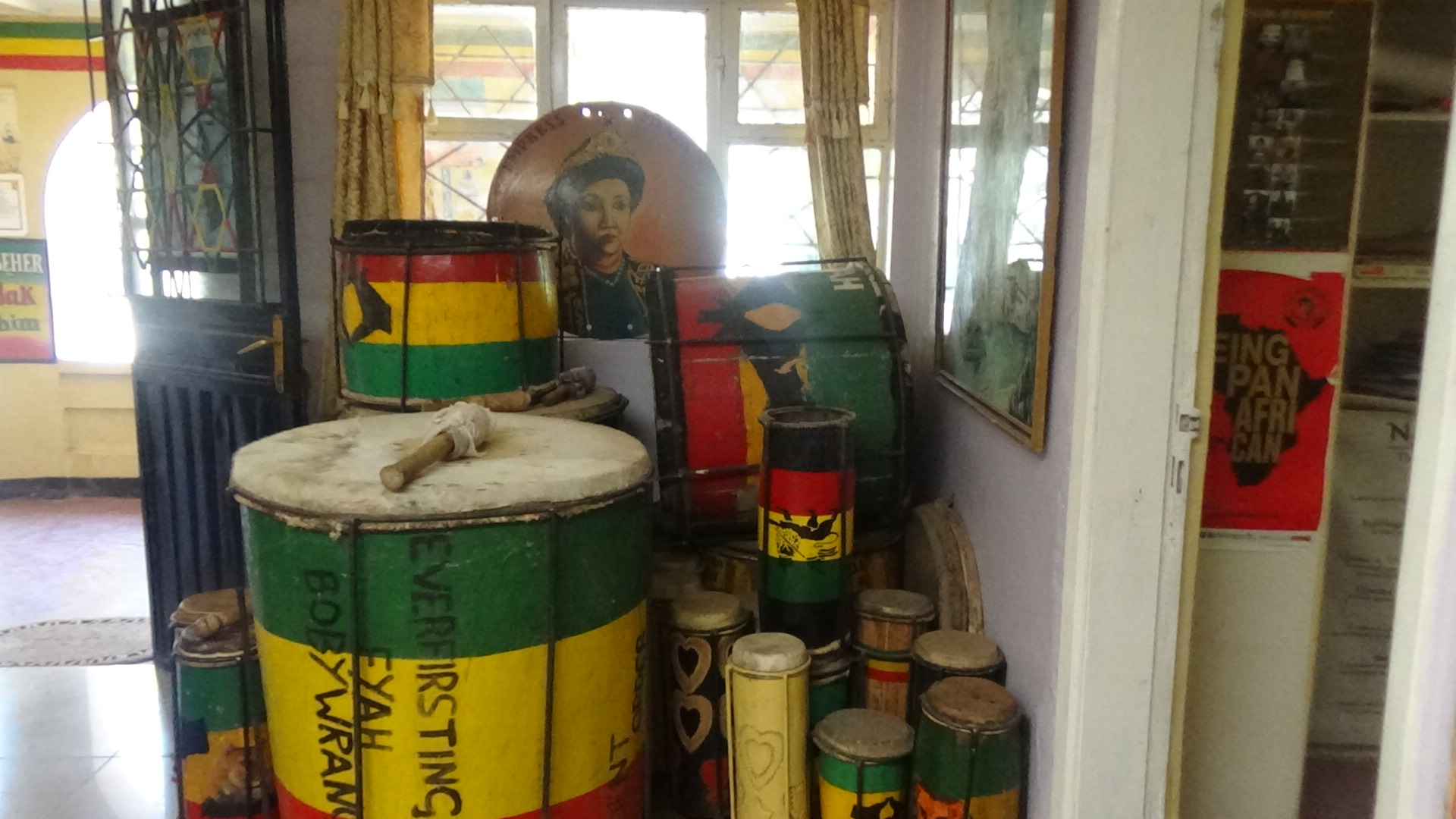This section consists of the film made by Mahlet Ayele Beyecha and Arnaud Lherm and a short summary of the thesis, the structure of which is also followed in the film.
The Thesis in Chapters
Challenges of the Rastafari in Ethiopia was originally the title of this research. In fact, initially, I went to the field with a hypothesis that the lives of the Rastafari community are full of challenges. I also assumed that if the community’s legal issue is resolved, I contended that they would all leave Ethiopia. However, the findings are completely the opposite. I was blown away by their determination and endurance. Thus, I decided this research should not only draw the readers’ attention to the vast records of challenges but also to throw light on the endurance and resilience rendered between the repatriate and the host as well. Upon my return from fieldwork, I had a conversation of my fieldwork report with my advisors, and the word “paradoxes” emerged as a catchy word to be added in the topic. The organization of the chapters of this research, therefore, is as follows:
Chapter One reasons out the methods employed in order to show from where the hypothesis emanates and events that shaped the approaches to the participants and the data collection. The methodology part offers a detailed overview of the people and places in Shashemene and Addis Ababa that shaped my research. The methods are scattered throughout the chapters as the experience and the manifestation of each chapter have a distinctive story to tell. Moreover, the chapter presents an overview of the people, the city of Shashemene, and the historical overview of the Rastafari movement.
In this chapter, I outline and reflect on how my personal background and lived experience in the Rastafari culture expedited the data gathering and my connection with the research. I have shared my personal story with regards to my positionality in the Rastafari movement. My insider and outsider position helped me out to navigate my way in collecting data. This chapter has laid out the stepping blocks for building the results of the research in the discussion part (see Chapters 3, 4, 5, 6 and 7).
Chapter Two provides background information for readers. Included are the historical account of the Rastafari movement consisting the pan-Africanism and religious dimension and a contemporary history of the movement. It offers explanation on the different mansion of the Rastafari to expand the knowledge on the Rastafari in general and on how these mansions operate on the ground in particular. The chapter looks at the way the Ethiopian government has approached the Rastafari community since the collapse of the monarchical rule in 1974. Moreover, it illuminates Ethiopianness and repatriation as perceived by the community. Though this chapter depends heavily on previous works on the subject, it also includes ethnographically collected data.
Having discussed the Rastafari movement from its inception in the Caribbean to the adherents’ repatriation to Ethiopia, the chapter examines the views of the last three successive Ethiopian governments in order to lay out the foundation for what led to their challenges and paradoxes of belonging in Ethiopia.
Chapter Three, through the stories of the lived experience, unravels the paradox of the lives of the returnees. Indeed, the experiences painted in this chapter overlap with the issues in the following chapter in view of cases discussed in deconstructing the paradox of the challenges but not all challenges are paradoxes. This chapter provides experiential accounts with reflexivity and introspectively apprehended evidences. In addition, it elucidates the empirical assessment that led to the subject matter, deconstruction of ironies and paradoxes. The unfolding of the paradoxes is presented content wise by dividing anecdotal evidences including the contradictory attitude of the Ethiopian government.
The Rastafari life even in its most mundane manifestation is loaded with paradoxes. The repatriation itself is not easy economically; and those who repatriated do not get what they expect: citizenship, and legitimacy in the country. The community suffers from all adversities on their face in the supposedly ‘promised land.’ Zion, home, motherland, etcetera, where they hoped to be relieved from all the tribulations and live in the ‘dreamland’ as they imagined it. On the other hand, as a result of this, and the way they are viewed by the host, they have become the Babylon they ran away from in the west and the Caribbean.
Having established the backdrop of the Rastafari movement by answering the what and how questions and its connection and Exodus to Ethiopia followed by uncovering the lenses used to approach the community, Chapter Four embarks on a broader view of the challenges of the Rastafari. It takes on the intimate journey of the lived experience of the repatriates, particularly in Shashemene and in Addis Ababa. The discourse includes men and women of both the old and young generations from all Rastafari households. The individuals paint their stories deviating from how they envisioned coming to Ethiopia, how they arrived, and their trials and tribulations in the Promised Land. These include the key challenges, misperception by the returnees and the host, legal issues, and the land grant, daily confrontations such as corruption, theft, bureaucracy, and challenges in establishing business among others. For a comprehensive understanding of the numerous forms of the Rastafari challenges, the research has thematized the challenges according to their distinctive nature such as cultural expression, acquiring legal status, land grant, challenges of the everyday and challenges within the community itself. The investigation notes a great deal of evidence that demonstrates the Rastafari’s resilience in the face of the daily adversities.
At the outset the display of adversities alongside with the Rastafari’s perseverance paints the paradoxical state of the community at max. By putting forward the resilience and endurance of the community, the research aims to demonstrate vehemently the devotion of the community to continue to call Ethiopia home despite the tribulations they are going through.
Chapter Five takes the reader to the continental and global Rastafari challenges. This chapter was materialized by an event that I turned into an opportunity. The All Africa Rastafari Gathering crashed by the diaspora Rastafari community from the Caribbean and the west was convened for the first time in the Mecca of the Rastafari , Shashemene, Ethiopia, on November 1-7, 2017. Participants of the conference volunteered to partake in this research and the result revealed that their challenges remarkably had universality. The study assesses the adversaries of Rastafari in Ethiopia whereby it unravels the perplexities and contradictions of the Rastafari in the Promised Land. With regard to this the purpose of this chapter is to examine the personal (and the community’s) encounters in their respective countries.
The narratives of the study participants exhibit the globalization of the Rastafari movement. In addition, the All Africa Rastafari gathering speaks for itself that the movement is embarking on transnational connections using its diasporic network, this will be discussed a bit further on the last section of the thesis.
The Ministry of Foreign Affairs of Ethiopia disclosed that national identification card issuance for the Rastafari community members. Moreover, the state has issued a directive that guides the implementation for official use. Curious to know if this brings an end to adversity of the community and a-happy-end the research with some cheering news, Chapter Six examines the guideline (“A Guideline to facilitate conditions for the Rastafari community in Ethiopia to get the Rights and privileges provided to foreign nationals of Ethiopian origin” No. 21/2009) juxtaposing with proclamation No. 270/2002 “A proclamation to provide Foreign Nationals of Ethiopian origin with certain Rights to be exercised in their country of origin,” and “Immigration Act”, 2000 (Act 573) of Ghana that provided “Right of Abode” for African descendants. The chapter contends that it is a no-win dilemma for the majority of returnees as they do not fully meet the requirement. The lack of official documentation puts the Rastafari in a vicious cycle of misery. Not only this. The core of their repatriation to Ethiopia, the land grant, remains unaddressed. The guideline provides a background for better understanding why it took the Ethiopian government half-a-century to legalize the returnees. It discusses the general issues on the guideline and impact of the directive on the Rastafari returnees, backed by interviews with Ministry and Authority officials. Following is relative advantages and shortcomings of complying with the guideline.
Following the current wave of change and the country’s opening of its doors for those who exiled, the Ethiopian diasporas, is pushing to be called Ethiopian which essentially will lead pushing for Ethiopian citizenship through dual citizenship. Under the condition that the directive 21/2009 is to enable the Rastafari to grant the rights and privileges given to foreign nationals of Ethiopian, then, by implication the Rastafari would as well get Ethiopian citizenship. Yet again the requirements may hinder the adherents from getting one in the absence of valid passport.
In the absence of an all-inclusive resolution by the state, the research try to look at what other means the Rastafari community in Ethiopia are looking at. From in-depth and follow up interviews I learnt that there is a tendency and some steps taken in approaching continental and international organizations to legalize their existence in the country. In the view of this, Chapter Seven of this study culminated. In doing so, it analyses depth conversation with this regard. Congruently it brings the view of the International Organization for Migration. The chapter briefly discusses the observation made during the All Rastafari Gathering conference under the theme “Intra-trade between the global Rastafari communities”.
The chapter offers a brief background on the general overview of Rastafari’s worldwide movement. The subsequent discussion is on the transnational connection of the Rastafari community in Ethiopia. To demonstrate this, it looks into the various manifestations of the connections of the community to international institutions and foreign offices like diplomatic corps. Wondering how their status is considered in the eyes of international organization, the research delivers the view of the United Nations International Organizations for Migration (UN-IOM). Further it examines the embedding of a transnational entrepreneurship through the formation of centralized annual meetings like All African Rastafari Gathering (AARG) and Rastafari Continental Council (RCC).
Conclusion
The conclusion part of the thesis thematically provides a brief core points and the final word on the topics discussed throughout the research. It offers the reverberance of the challenges of the community nationally (Ethiopia), continentally and internationally, and the measures taken that print its foot-step as to where the Rastafari are moving particularly in the African continent. This research, as the first exhaustive investigation on; the challenges and paradoxes of belonging of the Rastafari community in Ethiopia, a detailed discussion on the challenges that the community face, the practicability of the directive issued by the Ethiopian government in acknowledgment of the community, and the home-diaspora relationship of the Rastafari, renders those who wish to study the movement an in-depth contemporary study with indication of future phenomenon of the Rastafari movement within Ethiopia and Africa. Recognition by the state is considered the ultimate goal of the community in Ethiopia. However, this study uncovers that this is not what is actually sought by the group members and what the Ethiopian government granted them. The findings of this research not only help us broaden our understanding on the current predicament of the Rastafari community in Ethiopia and worldwide, but also assist individual Rastafari wishing to do the journey of repatriation to the Promised Land.
Will the Rastafarian community, in the wake of Dr. Tewodros’ successful designation at United Nations election and under the new progressive and charismatic leadership of Ethiopia under H.E. Dr. Abiy Ahmed, be granted citizenship? If the directive issued by the state of Ethiopia becomes flexible and inclusive of the majority, can this mean an end to their hardships in Ethiopia? When the common challenges of the transnational members of the community are shared to the African people, will it lead to building empathy and understanding? Will the new boom of the Rastafari organizations become the avant-garde of the movement? What are the benefits and implications? All these and others need further investigations.
This post is part of a series. It was first published on the Innovative Research Methods website (May 2020).
Other posts:







